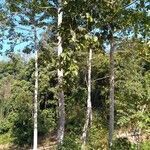Medium-sized tree. Twigs, panicles, flower calyx and corolla outside shortly densely buff puberulent or glabrous; petiole, leaf bud and ovary densely persistently pale orange-rufous silky tomentose or glabrous, stipule caducously so, becoming tufted glabrescent on expanding; leaf glabrescent. Twigs c. 8 mm ø apically, stout, becoming pale brown. Buds to 2.5 by 1 cm, ovoid-lanceolate, acute; stipule to 4 cm long, lanceolate, acute. Leaves 16-28 by 7-17 cm (to 50 by 70 cm in young trees), ± broadly elliptic-oblong, coriaceous, prominently plicate, drying dark chocolate-brown; nerves 16-19 pairs, prominent beneath, +-depressed above, ascending; tertiary nerves densely scalariform, very slender and hardly elevated beneath; petiole 2.5-7 cm long. Panicles to 10 cm long, unbranched, axillary. Flower bud to 3 by 1 cm, fusiform. Stamens 30, exceeding style at anthesis; filaments short, filiform; anthers long, linear, tapering; appendage acicular, slender, c. 1/2 length of anther. Ovary small, ovoid, densely pubescent as also the basal 2/3 of the stoutly columnar somewhat tapering style. Fruit pedicel to 3 by 4 mm, stout; calyx tube to 3.5 mm ø, subglobose, sparsely minutely pale lenticellate, smooth; 2 longer lobes to 25 by 4.5 cm, obtuse, prominently 3-nerved, tapering abruptly to c. 12 mm wide at base; 3 shorter lobes to 2 by 1.5 cm, prominent, ovate-elliptic, obtuse, subrevolute.
It is a ± branched tree 10–50 m. tall.. Leaves ovate to elliptic or oblong, ± 14–40 × 8–18 cm. (larger in juveniles), glabrous above, glabrous or fasciculate pubescent on the venation beneath; lateral nerves numerous, parallel, prominent beneath.. Long fruit-wings elongate-oblong, 10–25 × 2.2–4.5 cm.


